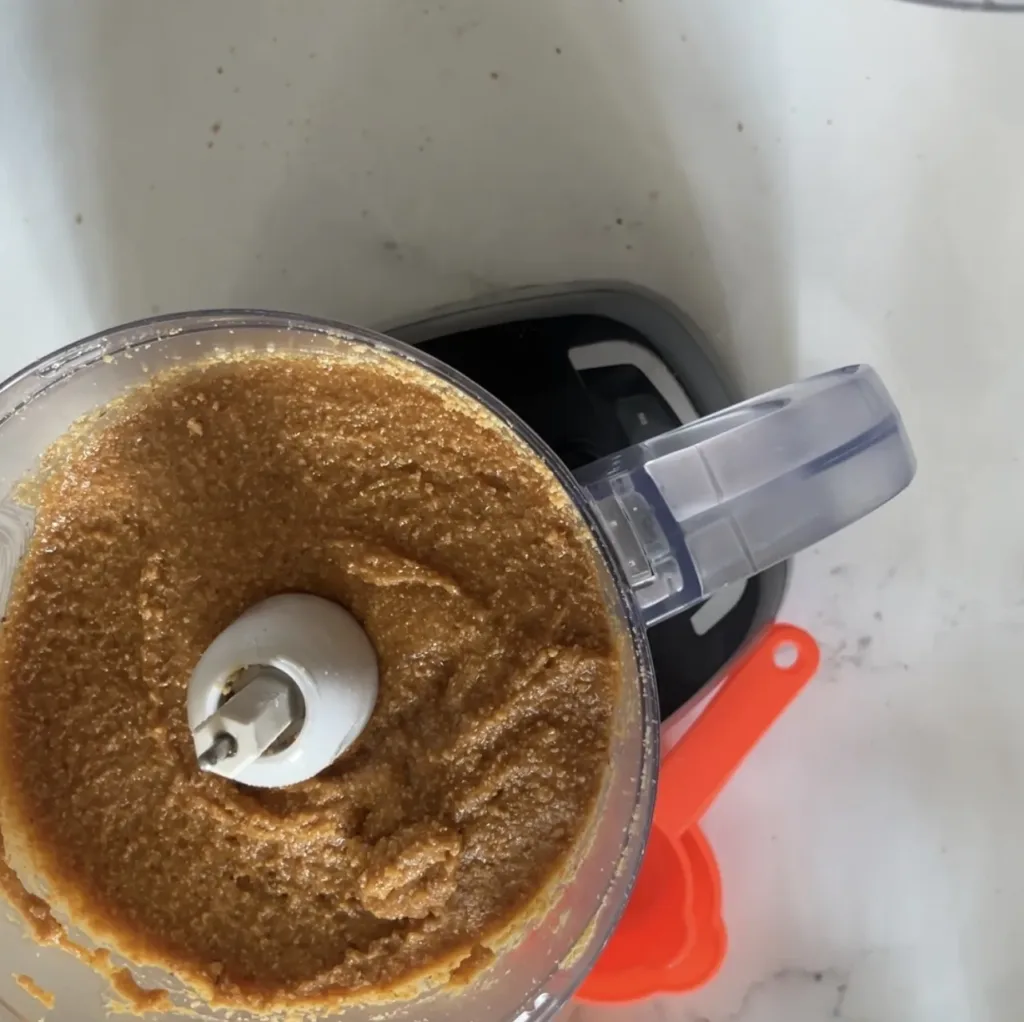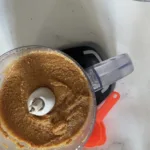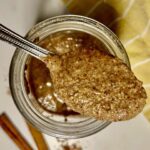If you’re tired of store-bought varieties and want to experience the rich, creamy goodness of freshly made peanut butter, you’re in the right place. In this blog post, we’ll guide you through a simple and satisfying recipe that will have you ditching the jars from the supermarket. Get ready to indulge in the purest form of nutty goodness with our homemade peanut butter recipe that is sure to satisfy your taste buds and elevate your snacking and baking game to a whole new level.
Your grocery list
Pantry Items
- Peanuts (roasted or not, salted or not)
- Sugar (granulated or pure cane sugar)
- Canola oil (or another oil of your choice – more discussed below)
- Kosher salt (only needed if using unsalted peanuts)
Equipment/tools you’ll need
- Measuring spoons/cups
- Food processor
- Rubber spatula
- Container or jar with lid (for storage)
Step-by-step guide to making peanut butter at home
Gather your ingredients
You will need 2 cups of roasted peanuts, 4-8 tablespoons of sugar (optional), 1/2 teaspoon of salt, 3-4 tablespoons of oil (such as peanut oil, vegetable oil, or coconut oil), and water (if needed).
If roasting the peanuts yourself
Using roasted peanuts is not necessary, but it is recommended. Roasting the peanuts, like all other ingredients, enhances the flavor. First, Preheat your oven to 350°F (175°C). Spread the peanuts evenly on a baking sheet and roast them for about 10-12 minutes, or until they turn golden brown. Make sure to shake the baking sheet occasionally to ensure even roasting. Allow the roasted peanuts to cool for a few minutes. Once they are cool enough to handle, rub them between your hands or wrap them in a clean kitchen towel and rub vigorously to remove the skins. Discard the skins.
Blend the peanuts
Transfer the roasted peanuts to a food processor or blender. Add the sugar (if using) and salt. Blend on high speed for a few minutes until the peanuts are finely ground and start to clump together.
Add oil gradually
With the food processor or blender still running, gradually drizzle in the oil. Start with 1 tablespoon and add more if needed to reach your desired consistency. The oil helps to bind the peanut butter and make it creamy.
Adjust consistency
If your peanut butter is too thick, you can add a little water, 1 tablespoon at a time, and continue blending until you achieve the desired consistency. Be careful not to add too much water, as it can make the peanut butter runny.
Taste and adjust
Stop the blender or food processor and taste the peanut butter. If desired, you can add more sugar or salt to suit your preference or even a pinch of ground cinnamon. Blend again briefly to incorporate any additional ingredients.
Store in a jar
Transfer the homemade peanut butter to a clean, airtight jar or container. It can be stored at room temperature for up to two weeks or in the refrigerator for up to three months.
Different types of oils used for making peanut butter
When making homemade peanut butter, it’s important to choose the right oil to achieve the desired flavor and texture. Here are some options:
- Peanut oil: This is the most common oil used in homemade peanut butter and is the best option if you want a pure peanut flavor. It’s also great for achieving a smooth and creamy texture.
- Canola oil: This is a good option if you want to keep the peanut flavor but also want a milder taste. Canola oil is also low in saturated fat and high in monounsaturated fat, making it a healthier choice.
- Sunflower oil: This oil has a neutral flavor, so it won’t affect the taste of your peanut butter. It’s also high in monounsaturated and polyunsaturated fats, making it a healthier option than some other oils.
- Coconut oil: This oil will add a subtle coconut flavor to your peanut butter and will also make it thicker and creamier. Coconut oil is a great option if you want a vegan or dairy-free peanut butter.
Ultimately, the choice of oil will depend on personal preference and dietary restrictions. However, it’s important to choose an oil that is high in healthy fats and low in saturated fats to ensure that your homemade peanut butter is as nutritious as possible.
What’s the difference between white sugar and pure cane sugar?
White sugar and pure cane sugar are both types of granulated sugars, but they differ in their sources and processing methods. White sugar can be made from either sugar cane or sugar beets and undergoes a refining process that involves removing molasses.
On the other hand, pure cane sugar (aka turbinado sugar) is specifically made from sugar cane and undergoes less processing, retaining more of its natural molasses content. This gives pure cane sugar a slightly different flavor and color compared to white sugar. However, in terms of calorie content and nutritional composition, both sugars are relatively similar.
In this recipe, white sugar will give you a smoother peanut butter. Using pure can sugar, which has larger sugar crystals, will result in a crunchy peanut butter texture.
How long will homemade peanut butter keep?
To store homemade peanut butter, transfer it to an airtight container and place it in the refrigerator or freezer for longer shelf life.
If stored in an airtight container in the refrigerator, homemade peanut butter can last for up to three months. If stored at room temperature, the peanut will be good for about two weeks. It is important to stir the peanut butter before each use to prevent the loss of moisture.
Homemade Peanut Butter
Equipment
- Measuring cups/spoons
- Food processor or blender
- Rubber spatula
- Airtight jar or container for storage
Ingredients
- 2 cups peanuts roasted
- 4-8 tablespoons sugar optional
- ½ teaspoon kosher salt
- 3-4 tablespoons oil peanut, canola, or vegetable
Instructions
- Transfer the roasted peanuts to a food processor or blender. Add the sugar (if using) and salt. Blend on high speed for a few minutes until the peanuts are finely ground and start to clump together.
- With the food processor or blender still running, gradually drizzle in the oil. Start with 1 tablespoon and add more if needed to reach your desired consistency. If your peanut butter is too thick, you can add a little water, 1 tablespoon at a time, and continue blending until you achieve the desired consistency.
- Stop the blender or food processor and taste the peanut butter. If desired, you can add more sugar or salt to suit your preference or even a pinch of ground cinnamon. Blend again briefly to incorporate any additional ingredients.
- Transfer the peanut butter to a clean, airtight jar or container. It can be stored at room temperature for up to two weeks or in the refrigerator for up to three months.



